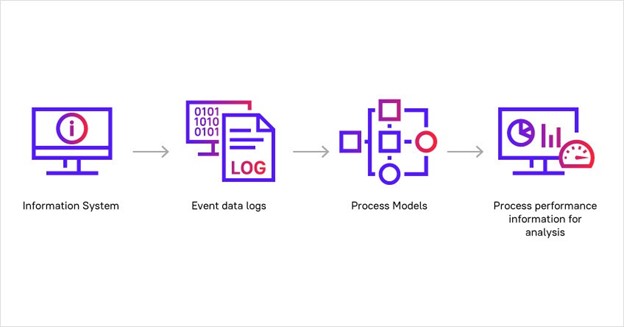
There is growing trend of integrating process mining features with BI, and some companies have built solutions on business intelligence tools.
The rise of process mining has opened a new frontier of software combination and collaboration. Enterprise software giants like Microsoft, SAP, and IBM are buying process-mining startups to add to their intelligent process automation capabilities. Beyond the giants, there are companies, big and small, joining the process mining industry via acquisition or with flashy new startups. Many of these companies are already specializing in automation, for example, Microsoft’s Power Automate. The trend seems to be moving towards organizations buying or building process mining technology to leverage its capabilities to accelerate the adoption of their primary offering of automation products. These new combinations of software are opening new industries, but are they opening an end to the stand-alone process mining industry?
Getting down to the basics
Process mining software is a tool based on event logs that enables organizations to understand their business processes, identify the bottlenecks, and improve the efficiency of their work. Some of the advantages that process mining software provides are:
- Helping to identify and resolve bottlenecks in processes,
- Providing a better understanding of workflows for better analysis and design,
- Identifying opportunities for process optimization, etc.
Applications such as ERP, CRM, ITSM, and other systems of record automatically create event logs that record the actions of users in workflows. The data in these logs can then be collected, or “mined,” to visually analyze the audit trail of the processes.

Before the process mining trend, the role of analyzing data had always required a lot of manual work to be put in for little results. No matter what process was being investigated, the business needs put demands on manually reviewing or writing endless lines of code to get answers. Process mining dramatically decreased this analysis time to understand business processes with ease. Business process owners were then able to easily connect to data sources and could immediately start to understand what was working and what was broken in their process execution systems. By itself, process mining technology is quite valuable in helping understand operations and process execution in real-time, but the real value to the enterprise lies in its ability to identify transformation and automation opportunities pre-implementation and to monitor the performance of automation bots in production post-deployment. It makes more sense that this fast-moving acquisition landscape may be less about process mining itself and more about what robotic process automation, business process management, and process mining can achieve together.
Process mining solutions have been seen as gateway technologies for many organizations to enable and scale robotic process automation and other transformation initiatives across their business. At this point, automation companies are chomping at the bit to give their customers access to insight that will help them mature their automation projects and sell more automation. Ultimately automation vendors are starting to hit roadblocks in finding new opportunities for transformation, and process mining solutions are the key to unlocking new projects and, of course, new revenue. Choosing the right technology can and will make a world of difference.
See also: Process Mining Comes to the Surface
Built from the same German building blocks
The term process mining was first coined in a research proposal written by Wil van der Aalst at the Eindhoven University in 1999. Since then, many process mining vendors have approached data analysis and process improvement in similar ways that were all learned from the graduate school education of their founders at Eindhoven University. These are all primarily based on the schema diagram approach. How can you differentiate one process miner from the other, with so many being shared alike?When the products become indistinguishable from each other, this leads to rapid commoditization, perhaps something we already see happen as automation players scoop up any stand-alone process mining solutions.
This isn’t anything to fear for the mature players. They’ve known process mining alone wasn’t enough to drive the types of operational improvements enterprises are seeking. That’s why partnerships and advanced integrations have been so important in the process mining industry. It is evident with process mining that you can detect repetitive work and then provide the information needed to automate it properly. However, the real gold is in the ability to build an ecosystem that can communicate with multiple systems and relay information back and forth when processes go wrong so BPM or RPA tools and even humans in the loop can take action to fix things. These real-time alerts and predictive capabilities give unprecedented insight and forward-looking control of process execution. Unfortunately, only a few have mastered this capability and escaped the stand-alone process mining feature set. Those still only offering the fundamental process schema analysis visualization should be the most worried as these will be the first to see the impact of commoditization. In today’s offerings, just about anyone can show process execution on a Visio-like diagram.
Why are automation companies so interested in process mining?
For many years, process mining applications have served business process owners with new understanding and insight capable of saving countless manual hours and helping businesses discover opportunities for improvement. By itself, this wasn’t enough. Recent acquisitions point to the logical evolution of prominent technology vendors that have the necessary process and operational data in their systems but lack the capability to understand and leverage that data for improvement. They already have the data, and they are finding out that they can provide more value to their customers with process mining to help make processes flow better, faster, and with fewer errors. According to Ernst & Young, 50 percent of initial robotic process automation (RPA) projects fail due to a lack of quantifiable process data. This new trend is giving automation vendors access to information to help identify ROI and sell bigger and better automation projects. There are also great successes too. Recently, a multinational telecommunications company used process mining to improve their customer support and service truck rolls. Within the first six weeks, the process intelligence solution uncovered how they could save $8 million after identifying the root cause of multiple repeated tasks and trucks being sent to the same service requests.
Intelligent process automaton success depends on an ecosystem
There’s more to your business than just order to cash, procure to pay, and ITSM processes. Many traditional tools are limited to connecting to specific data sources such as SAP, Oracle, Salesforce, or ServiceNow. It should be said that no one should be tied to one vendor or solution stack. Success depends on the ability of organizations to remain flexible and agile in their approach to process automation. The tools will help them thrive but should remain flexible and allow organizations to create their own automation ecosystem using best-in-breed solutions.
There is a rising trend of integrating process mining features with business intelligence, and some companies have built solutions on business intelligence tools like PowerBI and Qlik. This type of integration puts process understanding right within the BI consoles, which many companies already use. Others stand out with their unique vision of process understanding, control, and monitoring to assist the automation life cycle. Uniquely from the start, these solutions were coined as process intelligence from their founding and go beyond traditional process mining and spaghetti diagram analysis. A better approach is to use a “timeline” to create an unfiltered, unedited history of every process iteration from beginning to end. These timelines are then analyzed to be compared, filtered, searched, aggregated, etc., similarly to how a BI application analyzes records in a table. The importance of integrating with multiple backend systems that span the enterprise becomes necessary to make an impact on the entire process lifecycle.
These integrated technologies are moving from emerging technology integrations to an industry standard. It’s important to note that process intelligence solutions are on the rise, offering more than simple process mining. They aren’t glued to one automation or workflow tool. They help analyze all aspects of the organization, regardless of the system, and put people at the forefront of process automation. They expand into a new realm of task mining to help understand how people work and act as assistants and execution engines for process automation. They are opening up new industries beyond just process mining. They enable process improvement projects to reach a new level in delivering on the promises of greater productivity, reduced risk of compliance violations, and streamlined efficiency that can remove friction from customer experience, improve employee workflow, and offer a greater competitive edge.
Instead of building them, which some have tried, automation vendors buy these technologies and give their customers access to such features to more quickly onboard customers into their automation ecosystem. Will this continue to lead to faster commoditization of stand-alone solutions? It is possible because it has become essential that businesses understand processes and identify automation opportunities before automating them. Further industry consolidation lies ahead for process mining, BPM, ERP, and RPA players. These mergers and acquisitions move the enterprise toward more closely integrated cognitive automation and intelligent orchestration. Just don’t get stuck locked to one solution.




























